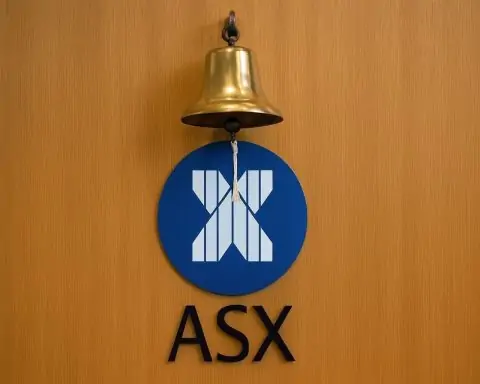Published: November 27, 2025 – Preview for U.S. market open on Friday, November 28, 2025
Dell stock into Black Friday: sharp rebound before a shortened session
As U.S. markets prepare to reopen for a shortened Black Friday session on Friday, November 28 (equities close at 1 p.m. ET), Dell Technologies Inc. (NYSE: DELL) is back in the spotlight after a dramatic two‑week swing. [1]
After being hit earlier in November by a rare double downgrade from Morgan Stanley, Dell shares have rebounded strongly following better‑than‑expected quarterly results and a powerful upgrade cycle in AI infrastructure:
- Last close before Thanksgiving: around $133.26, up about $7.34 (+5.83%) on the day, with trading volume above 16 million shares. [2]
- Year‑to‑date performance: roughly +9% in 2025, despite a sharp pullback from the early‑November high near $168. [3]
From a technical standpoint, DELL has bounced off mid‑$120s levels reached after the Morgan Stanley downgrade, but still trades well below its 52‑week peak around the high‑$160s. [4] Volatility is likely to stay elevated into Friday’s thin, holiday‑shortened session.
Q3 FY2026 recap: record revenue and a clean EPS beat
Dell’s fiscal third quarter 2026 (quarter ended October 2025) is the backdrop for the current move. The company reported record revenue and strong profit growth, driven largely by its Infrastructure Solutions Group (ISG):
Headline numbers
- Total revenue: about $27.0–27.01 billion, up roughly 11% year over year, but just under Wall Street’s ~$27.3 billion consensus. [5]
- GAAP EPS:$2.28, up roughly 39% from a year ago. [6]
- Non‑GAAP (adjusted) EPS:$2.59, up from $2.15 a year ago and ahead of analyst estimates near $2.48, delivering a solid earnings beat even with the modest top‑line miss. [7]
Segment performance
According to breakdowns compiled by Zacks / Nasdaq and other data providers: [8]
- Infrastructure Solutions Group (ISG)
- Revenue: ~$14.1 billion, up about 24% year over year
- Servers & networking revenue alone: ~$10.1 billion, up roughly 38%
- ISG operating margin expanded to about 12.4%, up from high‑single digits in the prior quarter
- Client Solutions Group (CSG – PCs & endpoints)
- Revenue: ~$12.5 billion, up around 3% year over year
- Commercial PC revenue grew mid‑single digits, while consumer PC revenue declined mid‑single digits
On a trailing‑twelve‑month basis, analysts at Simply Wall St estimate that Dell’s net profit margin has improved to about 5%, up from 4.6%, with roughly $5.2 billion in net income over the last year. [9]
From a pure earnings quality perspective, this quarter suggests Dell is successfully shifting its mix toward higher‑margin infrastructure and services, even as certain legacy PC categories remain soft.
AI server boom: the center of the Dell story now
The key driver behind the bullish reaction is Dell’s rapidly expanding AI server franchise:
- Management disclosed record AI server orders of about $12.3 billion in Q3, roughly double the prior quarter’s AI order book. [10]
- Year‑to‑date AI‑related orders have reached roughly $30 billion, highlighting strong enterprise and cloud demand. [11]
- Dell also raised its full‑year AI server shipment outlook to around $25 billion, signaling that AI infrastructure is now a core growth engine, not a side story. [12]
A separate analyst note cited by financial media reports that AI server revenue has grown more than 100% year over year, with some forecasts calling for roughly 50% additional growth next year as large customers continue to build out AI data centers. [13]
Research platforms like Smartkarma highlight a broadly bullish institutional stance: analysts there argue that Dell’s ISG business is positioned for a multi‑year AI infrastructure cycle, and that the latest quarter’s net income growth (up more than 30% year over year to around $1.5 billion) reflects that shift. [14]
Guidance raised: higher revenue and EPS targets through FY2026
The earnings beat was accompanied by meaningful guidance upgrades, which helped spark the post‑report rally:
- Full‑year FY2026 revenue guidance: now $111.2–$112.2 billion (mid‑point ~$111.7 billion), above prior forecasts and earlier company commentary. [15]
- Full‑year FY2026 EPS guidance: lifted to about $9.82–$10.02, from a prior range around $9.30–$9.80, implying mid‑teens earnings growth. [16]
- Q4 revenue outlook: roughly $31–$32 billion, again above many pre‑earnings expectations. [17]
Goldman Sachs noted that the updated guidance implies stronger EBIT growth (around 14% year over year) than previously expected, particularly in the ISG segment, and reflects confidence that AI servers can more than compensate for PC and services headwinds. [18]
Zacks currently assigns Dell a Rank #3 (Hold), suggesting the stock may perform broadly in line with the market near‑term, even as many fundamental metrics trend positively. [19]
Valuation snapshot: upside in analyst targets, but not without debate
With DELL trading around $133 going into the Black Friday session, the stock sits at an interesting crossroads:
- Price vs. analyst targets
- UBS recently set a $167 price target, implying over 30% upside from levels around the mid‑$120s at the time of the note. [20]
- Goldman Sachs lifted its target to $185 and reiterated a Buy rating, highlighting accelerating AI server demand and improved ISG margins. [21]
- Bank of America has discussed a target in the $160s, while JPMorgan is around $170 with an Overweight stance and a “positive catalyst watch” into the AI build‑out. [22]
- Valuation multiples
In other words, many bulls frame Dell as an AI‑levered value play: not priced like a hyper‑growth name, but with exposure to many of the same secular data‑center trends.
The bear case: memory‑chip supercycle and margin pressure
The picture is not one‑sided. The most prominent pushback came on November 17, when Morgan Stanley double‑downgraded Dell from “Overweight” to “Underweight”, slashing its price target from $144 to $110. [26]
Key points from that downgrade and related coverage:
- Rising memory costs
- Analysts highlighted a “supercycle” in DRAM and NAND prices driven by AI demand, with some components reportedly seeing price jumps of 50% to as much as 300% versus prior trough levels. [27]
- Since memory is a major cost in servers and PCs, Morgan Stanley argued that rising component prices could compress Dell’s gross margins over the next 12–18 months, particularly in hardware‑heavy lines.
- Share‑price impact
- Following the downgrade, Dell shares fell roughly 7–10% in a single session, briefly becoming one of the largest decliners in the S&P 500 and sliding into the mid‑$120s. [28]
- Sector‑wide concern
- The downgrade was part of a broader cautious stance on PC and server OEMs such as HP Inc. and Hewlett Packard Enterprise, which face similar exposure to memory costs, even as memory chip makers like Micron and SK Hynix benefit from the same trend. [29]
Importantly, this margin‑risk narrative has now been reinforced by Dell’s own management. On the Q3 call and in subsequent reporting, COO Jeff Clarke acknowledged that:
- Dell is seeing tight supply and rising prices for DRAM (including high‑bandwidth memory used in AI systems), NAND flash and some storage components.
- The company has, in his words, never seen costs moving this fast, and expects the higher cost base to eventually flow through to customers via configuration changes and, where necessary, higher equipment prices. [30]
That makes memory pricing one of the key macro variables for Dell’s margin story heading into 2026.
Other risks: consumer PCs, services and insider selling
Beyond memory, investors watching Dell stock into Friday’s open may also keep an eye on:
- Consumer PC softness
Dell’s consumer segment remains under pressure, with revenue down mid‑single digits year over year in Q3, even as commercial PC demand stabilizes. [31] - Services revenue dip
Zacks data show services revenue declining low‑single digits year over year, even while product revenue grew in the mid‑teens. That mix is acceptable for now, but lower‑margin hardware growth is more vulnerable to cost inflation. [32] - Insider activity
TrendSpider’s review of recent filings notes significant insider selling in recent months, including over $1 billion in share sales by CEO Michael Dell and large dispositions linked to director entities. While much of this may be pre‑planned, heavy insider selling at prior price levels in the $160s has drawn attention. [33]
These factors don’t negate the AI opportunity, but they add texture to the risk/reward profile as shares attempt to build a base above $130.
What to watch before the November 28, 2025 open
With U.S. markets reopening Friday after Thanksgiving for a shortened session and no major earnings on the docket, Dell could be one of the more actively traded tech names on the day. [34] Here are the key things traders and longer‑term investors are likely to watch:
- Follow‑through after the post‑earnings pop
- Does DELL hold above the $130 area that bulls defended after earnings, or does profit‑taking into the low‑liquidity holiday tape drag the stock back toward the mid‑$120s?
- Reaction to the guidance upgrades
- The market’s initial response to higher AI server and EPS guidance has been positive. The big question is how sustainable that optimism is once the excitement around the headline numbers fades.
- Ongoing analyst commentary
- With Goldman, UBS, BofA and JPMorgan raising or reaffirming bullish targets while Morgan Stanley remains cautious, Dell is shaping up as a classic “battleground” stock. Any fresh research notes could move the tape quickly. [35]
- Macro and sector flows
- Broader risk sentiment—especially in high‑beta tech—remains sensitive to U.S. rate‑cut expectations and AI‑related headlines. A risk‑on tape helps names like Dell; a sudden risk‑off move could quickly reverse recent gains. [36]
- Updates on memory supply and pricing
- Any additional commentary from suppliers or OEMs about DRAM/NAND shortages or price hikes will be parsed immediately for margin implications at Dell and its peers. [37]
Bottom line: a volatile AI infrastructure play into year‑end
Heading into the November 28, 2025 open, Dell Technologies stock sits at the intersection of two powerful forces:
- On the positive side:
- Record AI server orders and backlog
- Upgraded revenue and EPS guidance
- Expanding infrastructure margins
- A valuation and consensus target spread that still suggest potential upside from current levels
- On the negative side:
- A developing memory‑chip supercycle that could erode hardware margins
- Ongoing weakness in consumer PCs and some services lines
- Mixed analyst opinions and notable insider selling
For investors, that combination likely means continued volatility rather than a straight‑line move in either direction. Dell now trades less like a sleepy PC maker and more like a leveraged play on the AI data‑center build‑out, with all the opportunity—and execution risk—that implies.
As always, this article is for informational purposes only and does not constitute investment advice, a recommendation, or a solicitation to buy or sell any security. Anyone considering trading or investing in Dell Technologies should do their own research and consider consulting a qualified financial adviser.
References
1. www.kiplinger.com, 2. www.smartkarma.com, 3. www.smartkarma.com, 4. www.schaeffersresearch.com, 5. www.nasdaq.com, 6. www.kiplinger.com, 7. www.nasdaq.com, 8. www.nasdaq.com, 9. simplywall.st, 10. www.kiplinger.com, 11. www.kiplinger.com, 12. www.kiplinger.com, 13. seekingalpha.com, 14. www.smartkarma.com, 15. site.financialmodelingprep.com, 16. www.investing.com, 17. www.kiplinger.com, 18. www.investing.com, 19. www.nasdaq.com, 20. site.financialmodelingprep.com, 21. www.investing.com, 22. www.investing.com, 23. simplywall.st, 24. simplywall.st, 25. simplywall.st, 26. www.alphaspread.com, 27. www.barrons.com, 28. www.schaeffersresearch.com, 29. www.alphaspread.com, 30. www.straitstimes.com, 31. www.nasdaq.com, 32. www.nasdaq.com, 33. trendspider.com, 34. www.kiplinger.com, 35. www.investing.com, 36. www.kiplinger.com, 37. www.straitstimes.com







